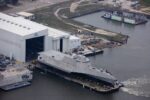At DSEI 2025 in London, Rheinmetall and Lockheed Martin jointly unveiled a next-generation tank destroyer concept vehicle aimed at countering modern armored threats. Designed around the proven Lynx KF41 chassis and equipped with a new high-power turret system optimized for anti-armor roles, the platform represents a transatlantic push to field a modular and survivable direct-fire solution for future battlefields.
Platform Overview: Leveraging the Lynx KF41 Chassis
The new tank destroyer concept is built upon Rheinmetall’s Lynx KF41 Infantry Fighting Vehicle (IFV) platform—a modular tracked vehicle already selected by Hungary and Australia for their respective modernization programs. The KF41 offers scalable protection levels (up to STANAG 4569 Level 6), high mobility via its Liebherr-developed powerpack (1,140 hp), and an open architecture design that facilitates rapid role adaptation.
For the tank destroyer variant revealed at DSEI 2025—currently referred to unofficially as the “Next Generation Tank Destroyer” (NGTD)—the rear troop compartment is replaced with advanced fire control electronics and ammunition storage. This configuration prioritizes lethality over transport capacity while maintaining sufficient armor protection against medium-caliber threats and artillery fragments.
Turret System: High-Power Anti-Tank Capability
The centerpiece of the NGTD is its newly developed turret system designed specifically for long-range anti-armor engagements. Rheinmetall has not disclosed full specifications yet but confirmed that it integrates a fully stabilized 120mm smoothbore cannon derived from the Rh120 L55A1 series—similar to what equips Leopard 2A7+ MBTs. The gun is compatible with NATO-standard APFSDS-T rounds as well as programmable HE munitions.
The turret features an autoloader system with up to 16 ready rounds stored in an armored bustle magazine. Secondary armament includes a coaxial 7.62 mm MG3 or FN MAG machine gun and optional integration of loitering munitions or ATGM launchers such as Spike LR2 or Javelin on side-mounted pods.
Fire control is handled by an advanced digital suite co-developed by Rheinmetall Electronics and Lockheed Martin’s Missiles & Fire Control division. It includes multispectral EO/IR sensors, laser rangefinders, ballistic computers with AI-assisted targeting algorithms, hunter-killer functionality via independent commander optics (ICOP), and full integration with NATO-standard BMS/C4ISR systems.
Modular Design Philosophy and Mission Flexibility
The NGTD reflects both companies’ commitment to modularity—a key trend in modern land warfare systems. Rheinmetall’s Lance turret family serves as the design basis but has been heavily adapted for anti-tank operations through reinforced recoil management systems, enhanced thermal signature suppression measures, and optional APS (Active Protection System) integration such as Trophy or Rheinmetall’s own StrikeShield.
The vehicle can be tailored for different mission sets including:
- Dedicated tank hunter role in support of light infantry formations
- Ambush operations in complex terrain where MBTs are vulnerable
- Mobile overwatch platforms during mechanized assaults
- Urban combat support using programmable airburst munitions
This flexibility makes it attractive not only to NATO armies seeking cost-effective alternatives to main battle tanks but also to allied nations requiring expeditionary firepower without heavy logistical burdens.
US-German Industrial Cooperation Context
This joint development marks another milestone in transatlantic defense collaboration between Rheinmetall—a core supplier of European armored systems—and Lockheed Martin—the world’s largest defense contractor by revenue. While Rheinmetall brings deep expertise in ground vehicle design and cannon technology, Lockheed contributes advanced sensor fusion capabilities and battlefield networking systems honed through programs like F-35 Lightning II and M270 MLRS upgrades.
The partnership aligns strategically with U.S. Army interest in optionally manned fighting vehicles (OMFV) under its Next Generation Combat Vehicle (NGCV) portfolio as well as European efforts under PESCO’s Eurotank initiative. Although no formal procurement has been announced yet, both firms confirmed they are positioning the NGTD for potential U.S., German Bundeswehr, Australian Army (as a Lynx user), and Eastern European tenders where mobile anti-tank solutions are increasingly prioritized due to lessons from Ukraine conflict dynamics.
Operational Relevance Amid Shifting Threat Environments
The resurgence of large-scale mechanized warfare—as seen in Ukraine—has revalidated the need for specialized anti-tank platforms capable of defeating modern MBTs equipped with ERA/NERA armor suites or APS defenses like Russia’s Afghanit or Israel’s Trophy. The NGTD aims to fill this niche by combining high first-round hit probability at extended ranges (>3 km) with rapid shoot-and-scoot capabilities enabled by its mobility profile (~70 km/h top speed).
Moreover, its compact size compared to full MBTs allows easier strategic transportability via C-17 or A400M aircraft—an advantage for rapid deployment forces operating across dispersed theaters such as Eastern Europe or Indo-Pacific islands.
Next Steps: Testing Roadmap and Export Prospects
No live-fire demonstrations have yet been conducted publicly; however, Rheinmetall confirmed that prototype trials will begin at its Unterlüß test center in Q1 2026. Integration testing of fire control software components began earlier this year under internal funding streams from both companies.
A full-scale demonstrator is expected to participate in dynamic displays during Eurosatory 2026 in Paris alongside other NGCV candidates. Industry analysts suggest that if customer interest materializes—especially from Eastern Europe—the program could accelerate into low-rate initial production by late 2027–early 2028 pending governmental approvals.
Conclusion
The unveiling of the next-generation tank destroyer concept by Rheinmetall and Lockheed Martin underscores growing demand for agile precision-strike ground vehicles optimized against peer adversaries’ armor formations. By fusing proven chassis technology with cutting-edge sensors and weapons integration—and leveraging transatlantic industrial synergies—the platform could emerge as a serious contender in future force structures emphasizing distributed lethality over platform mass alone.









